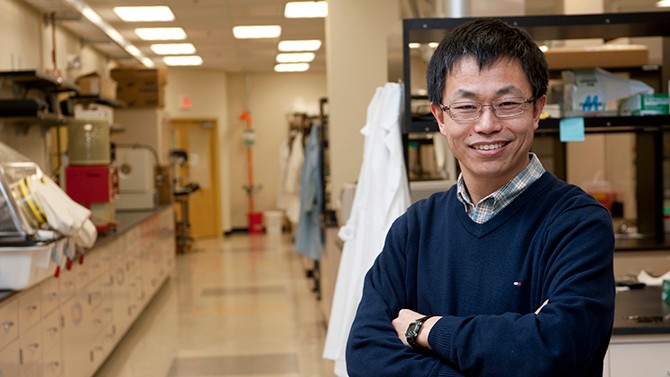UD awarded $1.8 million through new ARPA-E program aimed at transforming energy storage, conversion
The University of Delaware has been awarded $1.8 million in funding from the U.S. Department of Energy’s Advanced Research Projects Agency-Energy (ARPA-E) through its new IONICS (Integration and Optimization of Novel Ion-Conducting Solids) program.
IONICS project teams are paving the way for technologies that overcome the limitations of current battery and fuel cell products.
Led by Yushan Yan, Distinguished Professor of Engineering, the research at UD will focus on creating a series of polymer-based hydroxide exchange membranes (HEMs).
“Our HEMs provide excellent mechanical robustness while maintaining chemical stability and high conductivity,” says Yan. “Our goal is to develop a process to easily synthesize the polymer at scale, creating large area membranes for testing that are thinner than human hair. Production costs will be minimized by using lower cost ingredients in the manufacturing process.”
This membrane work is a critical part of a larger overall effort at UD to make platinum-free fuel cells a commercial reality for zero-emission cars. Yan’s group is addressing what is perhaps the biggest challenge facing fuel cells — cost.
He and colleagues recently reported a breakthrough that promises to bring down the cost of hydrogen fuel cells by replacing expensive platinum catalysts with cheaper ones made from metals like nickel. The researchers achieved the breakthrough by switching the operating environment from acidic to basic, which is enabled by the membranes like the one funded by this IONICS project.
The project, “Highly Conductive, Stable and Robust Hydroxide Exchange Membranes Based on Poly (Aryl Piperidinium),” is one of 16 funded through the $37 million program, which is aimed at transforming energy storage and conversion.
The Delaware-led team includes Yan, Bingjun Xu, Shimshon Gottesfeld, Junhua Wang, and Yun Zhao of UD’s Department of Chemical and Biomolecular Engineering; Shuang Gu, a former student, postdoc, and research faculty with Yan, now at Wichita State University in Kansas; Hui Xu of Giner Inc. in Massachusetts; and Bamdad Bahar of Xergy Inc. in Delaware.
According to ARPA, developments made under the IONICS program have the potential to increase the energy storage content for vehicle batteries by more than 30 percent over today’s lithium-ion batteries, reduce the cost of fuel cells for vehicles by 25 percent through a reduction of precious metal catalysts and expensive metal plates, and significantly reduce battery system costs for the grid to about $150/kWh (for a five-hour discharge time).
The funded projects also have the potential to improve U.S. energy security by enabling the production of more domestic, renewable energy while increasing economic competitiveness and reducing the country’s carbon footprint.

